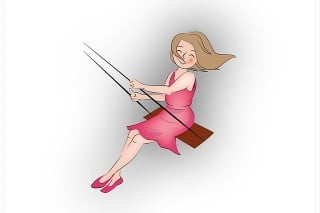

Sick
“Sick” is a famous poem by poet, cartoonist, songwriter, and musician Shel Silverstein published in book named “Where the Sidewalk Ends” in 1970. The poem is written from the perspective of a little girl named Peggy Ann McKay, who did not want to go to school.
Peggy Ann McKay came up with every single excuse she could, she is listing off all of her imagined ailments to avoid going to school. She is trying to convince her parents with all the innocent excuses with symptoms of various dreadful diseases such as the mumps and the measles, the chickenpox and other whatnots.
"Sick" Poem Lyrics
“I cannot go to school today,”
Said little Peggy Ann McKay.
“I have the measles and the mumps,
A gash, a rash and purple bumps.
My mouth is wet, my throat is dry,
I’m going blind in my right eye.
My tonsils are as big as rocks,
I’ve counted sixteen chicken pox
And there’s one more–that’s seventeen,
And don’t you think my face looks green?
My leg is cut–my eyes are blue–
It might be instamatic flu.
I cough and sneeze and gasp and choke,
I’m sure that my left leg is broke–
My hip hurts when I move my chin,
My belly button’s caving in,
My back is wrenched, my ankle’s sprained,
My ‘pendix pains each time it rains.
My nose is cold, my toes are numb.
I have a sliver in my thumb.
My neck is stiff, my voice is weak,
I hardly whisper when I speak.
My tongue is filling up my mouth,
I think my hair is falling out.
My elbow’s bent, my spine ain’t straight,
My temperature is one-o-eight.
My brain is shrunk, I cannot hear,
There is a hole inside my ear.
I have a hangnail, and my heart is–what?
What’s that? What’s that you say?
You say today is. . .Saturday?
G’bye, I’m going out to play!”
She claims that her hip hurts when she moves her chin and mentions that her belly button’s caving in and that her appendix “pains every time it rains”. But in the last lines of the poem when innocent Peggy Ann McKay notices that it is Saturday, then she wants to go out to play.
Despite the absurdity of her claims, the tone of the poem remains lighthearted and humorous, and the final twist at the end where she realizes it’s the weekend and runs off to play adds to the playful spirit of the piece. The poem is a fun and creative way to explore the ways in which children sometimes try to get out of going to school.
Despite the exaggerated and unlikely nature of the ailments, the speaker is able to maintain the illusion of being genuinely ill until the very end of the poem, when they suddenly realize it is Saturday and happily declare their intention to go out and play. The poem is a clever satire on the various tactics that children will use to try to avoid going to school and the creative ways in which they will try to get out of doing things they do not want to do.
Frequently asked questions (FAQ's) based on 'Sick'
Answer : The author of the poem “Sick” poem was Shel Silverstein.
Answer : Peggy Ann McKay is the main character in the poem.
Answer : The poem was published in the book named “Where the Sidewalk Ends”.
Answer : The poem “Sick” was published in 1970.
Answer : Peggy Ann McKay came up with the excuses in the poem.
Answer : Peggy Ann McKay came up with every single excuse she could because she don’t want to go to school.
Answer : Peggy Ann McKay came up with the excuses her appendix pains every time when its rain.
Answer : Peggy Ann McKay went to go out for play because she knows Saturday there was no school.
Answer : The poem has 32 stanzas and 4 lines.
Some more details based on 'Sick'
The poem’s narrator is a child who feigns illness in order to stay home from school. The narrator lists a series of increasingly outlandish ailments, such as a stomach ache, a headache, and even a broken bone. However, the final line of the poem reveals that the real reason the narrator is staying home is simply that they “don’t want to go to school.“
One of the main themes of the poem is the way children will go to great lengths to avoid doing something they don’t want to do. The poem is a lighthearted reminder that everyone, at some point in their life, has used the excuse of being sick to get out of something they didn’t want to do.
The poem was first published in Silverstein’s 1974 collection of children’s poems, “Where the Sidewalk Ends.” It quickly became one of the most popular poems in the collection, and has since been anthologized in several other books and collections.
One interesting feature of the poem is its use of exaggeration to create humor. The narrator’s increasingly outrageous list of ailments, such as a “broken leg and a broken head” and “a toothache, earache, and a headache,” is clearly meant to be comical, and helps to convey the absurdity of using illness as an excuse.
Another important theme of the poem is the way children navigate the complicated social dynamics of school. The narrator’s desire to stay home from school reflects a common experience among children who may feel overwhelmed or anxious in a school setting.
In terms of style, “Sick” is written in simple language with a regular rhyme scheme. This makes the poem easy to read and understand, and also makes it accessible to children who may be just learning to read and write.
Some activities for children's based on 'Sick'
Activity 1: Get Well Soon Cards
- Explain to the children that when someone is sick, it’s important to let them know that we care about them and wish them a speedy recovery.
- Provide the children with cardstock or construction paper and art supplies such as markers, crayons, and stickers.
- Ask them to create a get well soon card for someone who is sick, such as a family member, friend, or classmate.
- Encourage them to use their creativity and imagination to come up with a colorful and cheerful design, and to write a heartfelt message inside the card.
- Once everyone has finished their cards, have them share their work with the group and discuss how it feels to bring a smile to someone’s face when they are sick.
Note: This activity promotes empathy, creativity, and social emotional learning.
Activity 2: Healthy Habits Discussion
- Discuss with the children the importance of staying healthy and preventing sickness.
- Ask them to share their own tips for staying healthy, such as eating fruits and vegetables, washing their hands, and getting enough sleep.
- Brainstorm a list of healthy habits as a group, and create a chart or poster to display in the classroom.
- Encourage the children to practice these healthy habits every day and to help others do the same.
- For younger children, you can create a visual schedule that includes pictures of healthy habits and encourages them to follow along throughout the day
Note: This activity promotes health education, social emotional learning, and community building. By discussing and practicing healthy habits, children can learn how to take care of themselves and their peers, and develop positive habits that will benefit them throughout their lives.
Related links
Other popular poems
Other related keywords and search's
- i cannot go to school today poem
- sick poem by shel silverstein pdf
- sick poem by shel silverstein questions
- summary of the poem sick by shel silverstein
- sick poem pdf download
- sick poem full lyrics printable
- sick poem written in english
- sick poem shel silverstein meaning
- sick poem words and notes




















